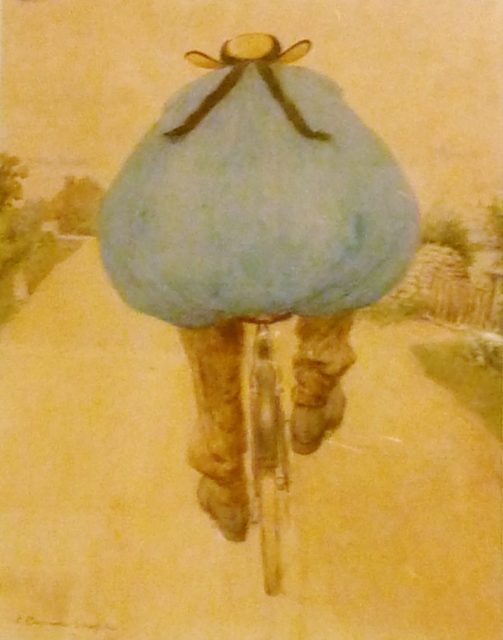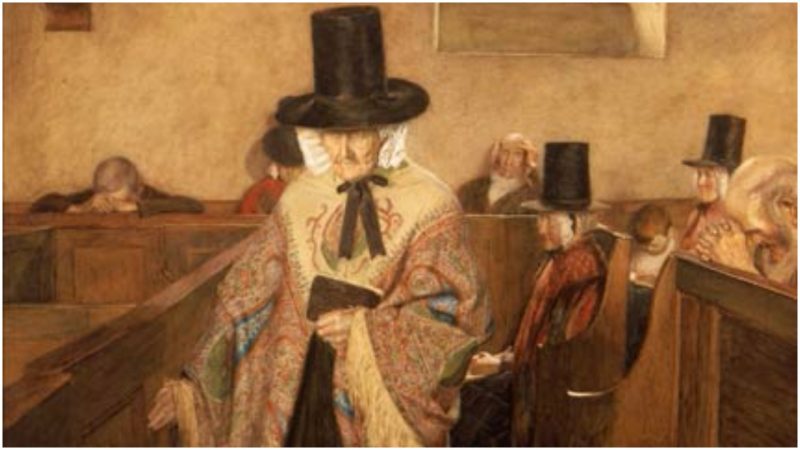Many painters throughout history have infused their works with carefully hidden Easter eggs–seemingly random details that actually convey meaning. For example, in his painting The Arnolfini Portrait, Jan van Eyck painted a mirror behind the Arnolfini couple; if that mirror is examined with a magnifying glass, the viewer can see the artist himself as he greets the couple upon entering. Also, a painting by Hans Holbein the Younger, entitled The Ambassadors, contains an unusual smudge on the floor. If the viewer looks at the painting from a specific angle, the smudge turns into an ominous skull that is often interpreted as a reminder of human fragility.
In 1908, an English painter, Sydney Curnow Vosper, painted Salem, which depicted the interior of a Baptist chapel, Capel Salem, in North Wales. The painting shows a traditionally dressed old woman at the center and several praying figures in the background. Vosper created a series of paintings that depict piety and religious devotion across the British Isles and, although Vosper was an Englishman, Salem became an icon of Wales. Nowadays, many Welsh museums and government institutions feature a framed print of the painting, while the original can be seen at the Lady Lever Art Gallery in Port Sunlight, England.

Ever since the artist first presented Salem, the painting has been a subject of debate among art critics and historians. Although the painting officially represents a pious and deeply religious scene, some of its details seem rather enigmatic, and it’s believed they might be pointing at a deeper and darker symbolic meaning: a representation of vanity. The central figure, modeled on an elderly Welsh woman named Siân Owen, is cloaked in a vividly colored and intricately ornamented shawl. Some researchers claim that the folds of the shawl around the old woman’s arm represent the face of the devil. Indeed, if one looks closely, it appears that contours of a mouth, eyes, and a beard can be discerned on the wrinkled piece of clothing.
Another detail that, according to critics, supports this theory is the clock on the wall of the chapel that points at 10 minutes after 10. This detail is significant because it may allude to the fact that the old woman at the center of the painting arrived at the church 10 minutes late, during the traditional silence that marks the beginning of the Welsh morning service.
While all other figures in the painting are seated and seem motionless, the old woman at the center is walking toward her seat. If there is truth to the theory that the painting represents vanity, the old woman deliberately came to the church at the time of the silent prayer so that the pious churchgoers could see her expensive and elaborate clothing, and the face of the devil in the folds of the shawl represents her sinful vanity.

From the painting’s emergence in 1908 until Vosper’s death in 1942, several interviewers asked the artist whether the cryptic details were intentionally incorporated into the painting, but he denied it and stated that he intended to depict a purely pious and religious atmosphere of an old-fashioned Welsh morning service. He also included Siân Owen in another one of his paintings, entitled Market Day in Old Wales, in which the old woman is dressed in much plainer traditional clothing.
Still, Vosper was an enigmatic painter who enjoyed incorporating hidden details in his paintings. He revealed that one particular detail was intentionally hidden in the Salem painting: the chapel window in the background contains a vague, ghostly face.
Although Vosper admitted that the mysterious face was intentionally added to the painting, he refused to comment on its meaning. Since this proves that Salem contains a hidden symbolic layer, one is left to wonder whether the devil in the details of the shawl is indeed an ominous representation of sinful vanity or a merely a strange example of pareidolia. In any case, Vosper’s Salem is a piece of artistic heritage that continues to amaze with its beauty and meticulous details.
